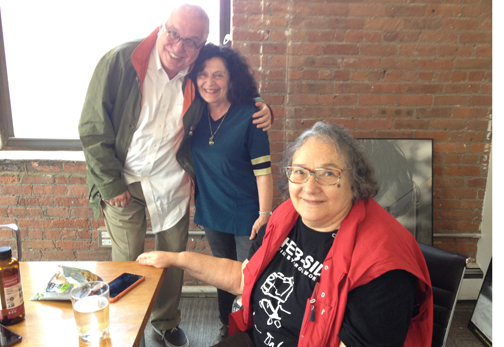
A longtime collaborator with Allen Ginsberg, Robert Creeley, and other literary figures, photographer Elsa Dorfman was a true American original. A portrait artist often associated with her main instrument, the large format 20" x 24" inch Polaroid camera, Dorfman, an influence to poets, and, from all reports, a great friend, died this week at 83.
In 2017, I met her when her pal Errol Morris made a film about her, The B-Side: Elsa Dorfman’s Portrait Photography, his most intimate documentary. Usually working with out-sized personalities, McNamara to Rumsfeld, the murderous gasman of Zyklon B, to name a few, documentarian Errol Morris has the further distinction with his 1985 The Thin Blue Line, of having changed the course of one man’s destiny with his investigative work, unearthing evidence that showed he was innocent of murder.
Elsa Dorfman, a neighborhood friend seems a smaller portrait indeed, but the filmmaker caught up with this mild-mannered photographer just as the Gentle Giant movers were removing some large-scale Polaroids for storage, so his picture of her surprises as it covers the technical aspect of Polaroid photography, and perhaps, the end of an era. This conversation from that time, as the film was about to open after a distinguished festival run including the New York Film Festival, reveals something of Dorfman’s charm. Errol and Elsa complete one another’s sentences.
How do you know one another, and what made you want to make a film?
Errol Morris: Elsa took my son Hamilton’s photograph when he was 4,
Elsa Dorfman: Now he’s 30.
EM: We live in the same town, Cambridge, MA, 16 blocks away. Elsa was always part of our lives. Our house is filled with Elsa’s Polaroids. The large, color ones are great. Elsa says photographs are connected with death and time. If you live with her photographs, it is true. Many people Elsa has photographed are dead. When you look at her photographs you are looking at time, memory. The most powerful parts of the film are Elsa looking at her own photographs, her mother and father, Allen Ginsberg.
Allen Ginsberg, famous as a poet, was also a photographer. Did you work with him?
ED: Yes, I knew him from 1959 till the day he died. He’s my son’s godfather.
Errol, When did you say aha this would be a good subject, and Elsa, when did you say I can do this?
EM: Usually a fair amount of money is involved in the apparatus of making a movie—we just decided to do it. Gentle Giant the moving company was going to Elsa and Harvey’s home and take the 60×40 Polaroids off the wall, where they were hanging in the stairwell forever and move them into storage. I thought we should be there when all of this goes down, and photograph this.
ED: I always thought I could do this, and when he would suggest it, I would say okay. Then one day he said, okay, I’m serious; 2 days later he said, okay, I’m ready and on Wednesday we’re making a movie. So I said, okay. I did not have much of a schedule to clear. That’s how I think it started. And since we are friends, we talked; this was part of our conversation. He had that background. Polaroid is a Cambridge company; everyone knew someone who worked at Polaroid. Living with something is different from seeing it in a museum. We took them down, because mavens said, the grain is cracking. 18 years of light. Gentle Giant took them down.
Elsa talks about Polaroids as a dying art. Is this movie chronicling the end of an era?
EM: Polaroid is moribund, not dead. Every photographer creates a relationship with the world. Kodak created cheap box cameras. Now with the ubiquity of cameras, suddenly, everyone with a cellphone has a camera. They are not distributed on paper any more. That was one of the sea changes in the world.
ED: I can’t get over that you cannot hold photos in your hand.
EM: I made a movie about the photographs at Abu Ghraib. [Standard Operating Procedure, 2008] The commander at Abu Ghraib thought he was going to round up all of the photographs, and then he would contain the problem, not realizing that they had been put on the Internet and sent all over the world and he had lost control over them. Polaroid did something revolutionary and different; they are under appreciated. Elsa and I are both interested in how people represent themselves on camera.
What was the biggest challenge of making the film?
We did not raise money; I paid for it and we started doing it. I had been doing a series for Netflix. One of the camera operators lived in New Hampshire. I got him to come down. We shot it in five days. Living room, two days in her studio, two days in the garage, the dark room for a day—so that’s six days. Still to create a feature in six days, that’s lucky, and lucky that Elsa turns out to be so good.

Leave a comment